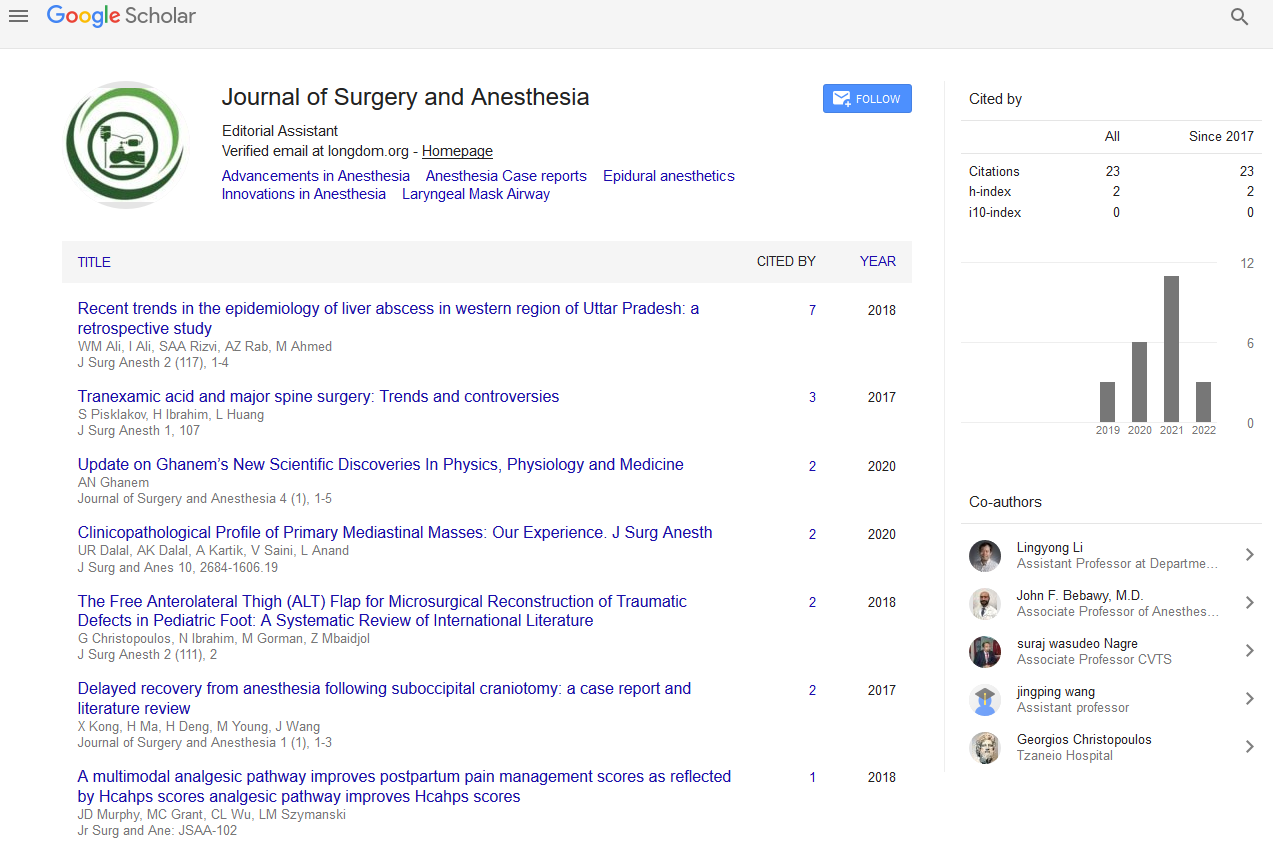Indexed In
- Google Scholar
Useful Links
Share This Page
Journal Flyer

Open Access Journals
- Agri and Aquaculture
- Biochemistry
- Bioinformatics & Systems Biology
- Business & Management
- Chemistry
- Clinical Sciences
- Engineering
- Food & Nutrition
- General Science
- Genetics & Molecular Biology
- Immunology & Microbiology
- Medical Sciences
- Neuroscience & Psychology
- Nursing & Health Care
- Pharmaceutical Sciences
Editorial - (2020) Volume 4, Issue 3
Advances in Anesthesia
Elizabeth T*Received: 26-Nov-2020 Published: 18-Dec-2020, DOI: 10.35248/2684-1606.20.4.e136
Advances during the last several decades have led to big improvements in clinical monitoring technology and clinical practice development, not only in patients undergoing surgery or in patients being cared for in Intensive Care Units (ICUs) but also in ambulatory patients. These developments have contributed to great improvements in patient safety. In addition, anesthesiologists world-wide have developed standards for continuous realtime monitoring of hemodynamics, oxygenation, ventilation, neurological status, urine output, core temperature, degree of neuromuscular blockade, also as other items, all of which have also contributed significantly to patient safety [1]. The practice of anesthesiology is inextricably dependent upon technology. Anesthetics were first made possible, then increasingly safe and now more scalable and efficient partially thanks to advances in monitoring and delivery technology [2,3].
Advances in anesthesia involve refinements in understanding, technique, and technology. These refinements have led to better control of the anesthetic state, effective anesthesia for a wider variety of situations, and the ability to bring sicker patients to the operating room [1,4]. Although the molecular mechanisms underlying the overall anesthetic state are unknown, evidence suggests a selected, receptor-based effect. This concept has allowed anesthesiologists to treat anesthetic end points of immobility, lack of awareness, and autonomic control separately. It is likely that anesthesia and present sleep interact physiologically. New, processed EEG monitors may allow anesthesiologists to titrate more finely anesthetic dose, with possible benefits in terms of speed of recovery and detection of intraoperative awareness. Since the 1990s, new anesthetic drugs (propofol, desflurane/ sevoflurane, cisatracurium) have enhanced greatly control of the anesthetic state [2-4].
The new anesthetic agent dexmedetomidine offers sedation with preserved respiration and cognitive function. Although its role has yet to be defined fully, it currently plays a task in ICU sedation and monitored anesthesia care.
New anesthesia ventilators have better monitoring and better flow delivery at high airway pressures. These improvements significantly narrow the performance gap between anesthesia and ICU ventilators. In patients with COPD, pulmonary hypertension, or severe hypoxemia, heliox may improve gas flow and NO may reduce pulmonary vascular resistance and improve oxygenation.
Coprescription of naloxone with opioids has been widely recommended for patients on chronic opioid therapy who have risk factors for overdose. Multiple prototype devices are created to guard health care workers from droplet or aerosol contamination during intubation and extubation of patients with COVID-19. However, a number of these devices may increase exposure of health care workers and patients to airborne particles and should make intubation harder [3].
Moderate sedation with monitored anesthesia care (MAC) instead of general anaesthesia is increasingly getting used for transcatheter semilunar valve implantation (TAVI), although comparative outcome data are limited. In a randomized trial comparing these techniques in nearly 450 patients with aortic stenosis undergoing transfemoral TAVI, the composite endpoint was similar for both groups. The bag-mask ventilation technique typically used during ECT procedures incurs high risk for aerosol generation and consequent infection of participating clinicians, particularly anesthesia providers managing the airway. Strategies and specific precautions are developed to attenuate infection risk during anesthetic management for ECT procedures, although these may vary consistent with local resources [5].
Along with technological innovation, social engineering and the constructs of efficient business will help increase quality and value in anesthesia care. Innovation in anesthesiology continues to be driven by the triple aim of health care for the benefit of patients and society.
Citation: Elizabeth T (2020) Advances in Anesthesia. J Surg Anesth 4:e136.
Copyright: © 2020 Elizabeth T. This is an open-access article distributed under the terms of the Creative Commons Attribution License, which permits unrestricted use, distribution, and reproduction in any medium, provided the original author and source are credited.

